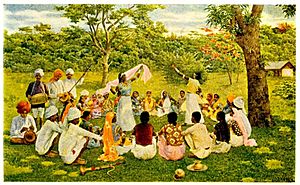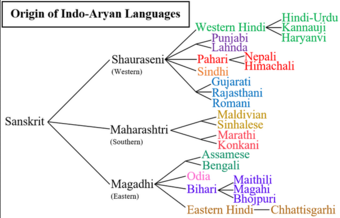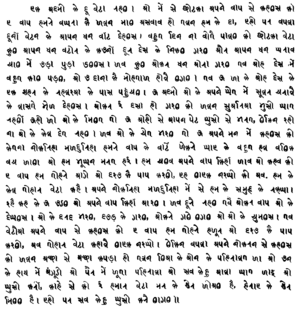Bhojpuri language facts for kids
Bhojpuri (pronounced boh-j-POOR-ee) is a language spoken mainly in parts of India and Nepal. It belongs to the Indo-Aryan language family, which includes many languages spoken across India, like Hindi and Bengali. Bhojpuri is mostly spoken in western Bihar, eastern Uttar Pradesh, and northwestern Jharkhand in India, and in the Terai region of Nepal.
It's also spoken by people of Indian origin in other countries like Fiji, Guyana, Mauritius, South Africa, Suriname, and Trinidad and Tobago. For example, Fiji Hindi, an official language in Fiji, is a mix of Bhojpuri and another language called Awadhi. Another version, Caribbean Hindustani, is spoken by people of Indian heritage in the Caribbean.
Quick facts for kids Bhojpuri |
||||
|---|---|---|---|---|
| भोजपुरी | ||||

The word "Bhojpuri" in the Devanagari script
|
||||
| Native to | India and Nepal | |||
| Region | Bhojpur-Purvanchal | |||
| Ethnicity | Bhojpuris | |||
| Native speakers | 51 million, partial count (2011 census) (additional speakers counted under Hindi) |
|||
| Language family |
Indo-European
|
|||
| Early forms: |
Magadhi Prakrit
|
|||
| Dialects |
Northern Standard Bhojpuri
Western Standard Bhojpuri
Southern Standard Bhojpuri
Tharu Bhojpuri
Madheshi
Domra
Musahari
Caribbean Hindustani
· Trinidadian Hindustani · Guyanese Hindustani · Sarnami Hindoestani Nagpuriya Bhojpuri
Mauritian Bhojpuri
South African Bhojpuri (Naitali)
|
|||
| Writing system |
|
|||
| Official status | ||||
| Official language in | ||||
| Recognised minority language in | ||||
| Regulated by |
|
|||
| Linguasphere | 59-AAF-sa | |||
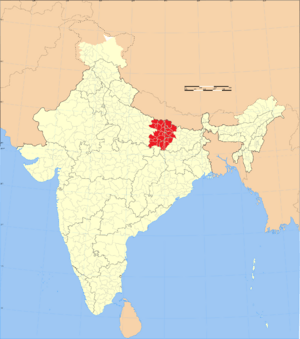
Bhojpuri-speaking regions of India
|
||||
|
||||
Contents
What's in a Name?
The name "Bhojpuri" comes from a region called Bhojpur. This area was named after Raja Bhoj, a king whose descendants settled there in the 12th century. The word Bhojpuri or Bhojpuriya then started to mean the language or people from this region and beyond.
Long ago, people from the Bhojpuri region were called by different names depending on where they were. For example, in Mughal armies, they were called Buxariya. In Bengal, they were known as Paschhimas (meaning Westerners).
When people from this region moved to British colonies, they often called their language simply Hindustani or Hindi. This is how names like Fiji Hindi and Caribbean Hindustani came about.
A Look at History
Bhojpuri developed from an older language called Magadhi Prakrit. Here's how it grew over time:
Early Beginnings (700-1100 A.D.)
The very first forms of Bhojpuri can be seen in old writings from around the 8th century. This was a time when early folk stories and religious texts began to appear.
Growing Stronger (1100-1400 A.D.)
Between the 11th and 14th centuries, many popular folk tales like Lorikayan and Sorathi Birjabh became well-known. During this time, Bhojpuri started to take on its own unique features and spread to different areas.
The Era of Saints (1400-1700 A.D.)
In this period, many important religious teachers, like Kabir and Dharni Das, used Bhojpuri to share their ideas. This helped the language become even more widely used. Also, words from Arabic and Persian languages started to become part of Bhojpuri.
British Influence and Global Reach (1800-1900 A.D.)
During the 19th century, British scholars began to study Bhojpuri. They created maps of the Bhojpuri-speaking region and even wrote the first grammar book for the language in 1868.
This was also when Bhojpuri became an international language! Between 1838 and 1917, many workers from the Bhojpuri region traveled to British and Dutch colonies like Fiji, Mauritius, Guyana, Trinidad and Tobago, and Suriname. They went to work on plantations, and they took their language with them. This led to new music styles like Chutney music and Baithak Gana in those countries.
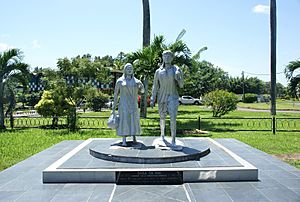
Modern Times (1900 - Present)
In the 20th century, famous writers like Bhikhari Thakur made big contributions to Bhojpuri literature and theater. His plays, like Bidesiya, are still well-known. In 1962, the first Bhojpuri film, Ganga Maiyya Tohe Piyari Chadhaibo, was released. This movie helped start the Bhojpuri film industry, which is still popular today.
Where is Bhojpuri Spoken?
The Bhojpuri-speaking region covers about 73,000 square kilometers in India and Nepal. It shares borders with other language regions, like Awadhi to the west and Nepali to the north. In Nepal, Bhojpuri is a major language.
Some Bhojpuri speakers also live in Pakistan and Bangladesh. They moved there during the Partition of India and are sometimes called "Stranded Pakistanis" because they speak Bhojpuri and Urdu instead of Bengali.
Many Bhojpuri speakers are descendants of workers who were brought to British colonies in the 19th and early 20th centuries. These communities can be found in places like Mauritius, Fiji, South Africa, Trinidad and Tobago, Guyana, Suriname, and Jamaica.
How is Bhojpuri Classified?
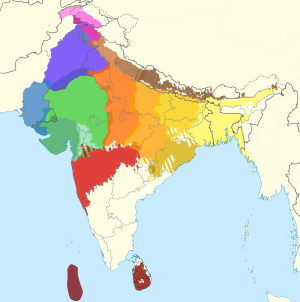
Bhojpuri is part of the Indo-European language family, which is one of the largest language families in the world. More specifically, it belongs to the Eastern Indo-Aryan group. This group also includes languages like Maithili, Magahi, Odia, Bengali, and Assamese. These languages are all closely related to Bhojpuri.
Bhojpuri, along with Magahi and Maithili, are often grouped together as the Bihari languages. They all come from an ancient language called Magadhi Prakrit.
One interesting thing about Bhojpuri is how it uses sounds. For example, the vowel a can be pronounced in different ways, which gives the language a unique sound. Also, in Bhojpuri, adjectives usually don't change their form based on whether the noun is masculine or feminine, which is different from some other languages.
Different Ways of Speaking Bhojpuri
Bhojpuri has several different ways of being spoken, called dialects. The main ones are Southern Standard Bhojpuri, Northern Standard Bhojpuri, Western Standard Bhojpuri, and Nagpuria Bhojpuri.
- Southern Standard Bhojpuri is common in areas like Shahabad district and Saran division in Bihar, and parts of Uttar Pradesh and Jharkhand.
- Northern Bhojpuri is spoken in western Tirhut division in Bihar and parts of Gorakhpur division and Basti division in Uttar Pradesh, as well as in Nepal.
- Western Bhojpuri is found in areas like Varanasi division and Azamgarh division in Uttar Pradesh. Sometimes it's called Banarasi after the city of Banaras.
- Nagpuria Bhojpuri is spoken in the southern part of Jharkhand, especially in the Chota Nagpur Plateau.
How Bhojpuri is Written
Historically, Bhojpuri was written using a script called Kaithi. This script was used for official documents in the Mughal era for Bhojpuri and other languages. However, since 1894, the Devanagari script has become the main way to write Bhojpuri. Devanagari is the same script used for Hindi and Nepali.
Today, almost all Bhojpuri texts are written in Devanagari, even in countries outside of India where Bhojpuri is spoken. The Kaithi script is rarely used anymore.

Being Polite in Bhojpuri
Bhojpuri has a special system for showing politeness when you speak. There are different ways to say the same verb or adjective, depending on how polite or formal you want to be.
For example, the word "your" can be said in several ways:
- tum (very casual, for close friends or younger people)
- tōhār (polite but still friendly)
- rā'ur (more polite and formal)
- āpke (very formal, showing great respect)
Even though there are many levels, Bhojpuri speakers usually use tu to address someone younger and raua for someone older or in a higher position.
Status of Bhojpuri
People have been asking for Bhojpuri to get more official recognition in India, like being included in the Eighth Schedule to the Constitution of India. In 2018, Bhojpuri was given the status of a second language in the state of Jharkhand, India.
Bhojpuri is taught in schools and universities in India, including Veer Kunwar Singh University and Banaras Hindu University. This helps keep the language alive and growing.
Bhojpuri Literature and Media
Bhojpuri has a rich tradition of literature. The Lorikayan is a famous collection of Bhojpuri folk stories. Bhikhari Thakur's play Bidesiya is a very important work in Bhojpuri theater.
The first Bhojpuri newspaper, Bagsar Samāchar, was published in 1915. Bhojpuri journalism grew a lot in the 1960s and 1970s. Today, many Bhojpuri magazines and newspapers are published in Bihar, Jharkhand, and Uttar Pradesh. There are also Bhojpuri TV channels like Mahuaa TV and Hamar TV.
The Bhojpuri Wikipedia was started in 2003, and in 2022, Google Translate added Bhojpuri as one of its languages, making it easier for people around the world to understand and use it.
Bhojpuri Words You Might Know
Bhojpuri vocabulary has many similarities with other Indo-Aryan languages. It also has words borrowed from Persian, Arabic, and even English.
Days of the Week
| English | Bhojpuri (Latin script) | भोजपुरी (देवनागरी लिखाई) |
|---|---|---|
| Sunday | Eitwaar | एतवार |
| Monday | Somaar | सोमार |
| Tuesday | Mangar | मङर |
| Wednesday | Budhh | बुध |
| Thursday | Biphey | बियफे |
| Friday | Sook | सूक |
| Saturday | Sanichar | सनिचर |
Common Phrases
| English | Bhojpuri | भोजपुरी |
|---|---|---|
| Hello | Raam Raam/Parnaam | राम राम/परनाम |
| Welcome/Please come in | Aain na | आईं ना |
| How are you? | Ka haal ba?/Kaisan hava? | का हाल बा?/कइसन हवऽ? |
| I'm good. And you? | Hum theek baani. Aur rauwa?/Hum theek hañi. Aur aap? | हम ठीक बानी। अउर रउवा?/हम ठीक हईं। अउर आप? |
| What is your name? | Tohaar naav ka ha?/Raur naav ka ha? | तोहार नाँव का ह?/राउर नाँव का ह? |
| My name is ... | Hamar naav ... ha | हमार नाँव ... ह |
| What's up? | Kaa hot aa? | का होता? |
| I love you | Hum tohse pyaar kareni/Hum tohra se pyaar kareni | हम तोहसे प्यार करेनी/हम तोहरा से प्यार करेनी |
Numbers
| English | Bhojpuri (Latin script) | भोजपुरी (देवनागरी लिखाई) |
|---|---|---|
| One | ek | एक |
| Two | du | दु |
| Three | teen | तीन |
| Four | char | चार |
| Five | pan | पान |
| Six | chhav | छव |
| Seven | sat | सात |
| Eight | aath | आठ |
| Nine | nav | नव |
| Ten | das | दस |
| One hundred | ek say | एक सव |
| Five hundred | pan say | पान सव |
| One thousand | ek hajar | एक हजार |
Example Text
Here's Article 1 of the Universal Declaration of Human Rights in Bhojpuri:
- Bhojpuri (Devanagari) – अनुच्छेद १: सबहि लोकानि आजादे जन्मेला आउर ओखिनियो के बराबर सम्मान आओर अधिकार प्राप्त हवे। ओखिनियो के पास समझ-बूझ आउर अंत:करण के आवाज होखता आओर हुनको के दोसरा के साथ भाईचारे के बेवहार करे के होखला।
See also
 In Spanish: Idioma bhoshpuri para niños
In Spanish: Idioma bhoshpuri para niños
- Culture of Bhojpuri Region
- Bhojpuri cinema


